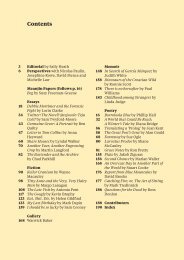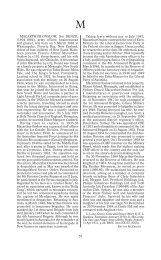Tiwi layout v2 ch 16 Munupi.pdf
Tiwi layout v2 ch 16 Munupi.pdf
Tiwi layout v2 ch 16 Munupi.pdf
You also want an ePaper? Increase the reach of your titles
YUMPU automatically turns print PDFs into web optimized ePapers that Google loves.
captions to go here captions<br />
to go here captions to go here<br />
captions to go here captions<br />
to go here captions to go here<br />
captions to go here captions<br />
to go here captions to go here<br />
captions to go here captions<br />
captions to go here captions<br />
to go here captions to go here<br />
captions to go here captions<br />
to go here captions to go here<br />
captions to go here captions<br />
to go here captions to go here<br />
captions to go here captions<br />
over time the appeal of this brighter aesthetic waned as<br />
influences in Aboriginal art and public taste began to<br />
revert to earth colour and natural o<strong>ch</strong>res. The artistic<br />
success of the ‘old ladies’ of Jilamara (see page xxx),<br />
Kitty Kantilla and Freda Warlapini, and their massive<br />
assistance to the viability of the Jilamara art enterprise,<br />
forced successive art advisers at <strong>Munupi</strong> to rethink<br />
their strategy, and over time most of the artists <strong>ch</strong>ose<br />
to return to basics, collect bush o<strong>ch</strong>re and work with<br />
that and softer colours. The flamboyance evident in the<br />
murals that still grace the artists’ work area at <strong>Munupi</strong><br />
<strong>ch</strong>anged <strong>layout</strong> a little<br />
was eventually contained. At the same time, numerous<br />
Indigenous communities had gone into print-making<br />
and the competition had become fierce. Locally<br />
produced prints were discontinued as uneconomic,<br />
and <strong>Munupi</strong> began to send artists to outside print<br />
workshops as funding became available, particularly to<br />
Northern Editions at Charles Darwin University.<br />
pi r lang i m pi potte ry<br />
The Pirlangimpi Pottery, Eddie Puruntatameri’s<br />
second pottery, was built in an adjunct building once<br />
an old storehouse owned by the Pirlangimpi Council.<br />
This continued the tradition of making functional<br />
pottery—thrown domestic bowls, vases, cylinders and<br />
platters in earthenware. In 1986, with a grant from<br />
the Aboriginal Arts Board and a small electric kiln,<br />
Eddie Puruntatameri was able to take on trainees, who<br />
included his son Cecil and Regis Pangiraminni, who<br />
had worked at <strong>Tiwi</strong> Pottery on Bathurst Island. Adult<br />
education tutor and potter Mark Lindberg helped<br />
Eddie set up the pottery and built a double-<strong>ch</strong>amber<br />
Bouri box kiln to Ivan McMeekin’s design.<br />
Pirlangimpi Pottery developed using different<br />
ceramic processes and media. Clay and glazes were<br />
initially bought from commercial suppliers and fired<br />
to earthernware temperatures. Apart from Eddie, the<br />
workers and trainees were not adept on the potter’s<br />
wheel, so a jigger-and-jolly was utilised to form the clay<br />
into bowls and plates and a heavy slab-roller prepared<br />
sheets of wet clay for hump-moulded platters. The<br />
surfaces of the earthenware pots were painted with<br />
<strong>Tiwi</strong> decorative patterns in bright and colourful<br />
underglazes, and a shiny clear glaze was used to finish<br />
surfaces. In an innovative move, elegant patterns were<br />
hand-painted by the women artists to decorate pots<br />
made by their male relatives. Maree Puruntatameri,<br />
who was also print-making and painting at <strong>Munupi</strong>,<br />
and other family members often decorated forms made<br />
by Eddie Puruntatameri.<br />
In July 1993 Maureen Spencer, a Darwin-based<br />
potter, was engaged to assist with management and<br />
supervision. Her encouragement of the use of colour<br />
and new decorative te<strong>ch</strong>niques resulted in a highly<br />
successful exhibition at Raintree Gallery in Darwin<br />
in October that year.<br />
Eddie Purantatameri’s work continued to be<br />
recognised and appreciated by potters throughout<br />
Australia. Although pleased with the reception accorded<br />
his colourful earthenware pottery, he longed to be able<br />
to produce stoneware again. However, he knew that the<br />
lengthy firings, stoking the kiln with timber, required<br />
more trained, skilled hands than he had available at<br />
<strong>Munupi</strong>. In 1994 he spent time at Kormilda College in<br />
swapped pic of robert to profile><br />
Darwin, where he demonstrated pottery and enjoyed<br />
continuing the tradition of making significant works<br />
for major events—for the Chur<strong>ch</strong>, or for Australian<br />
Rules football mat<strong>ch</strong>es. In August 1995 his life’s work<br />
rea<strong>ch</strong>ed its zenith when his ceramics were exhibited at<br />
the Ceramic Art and Perception Gallery in Sydney. In<br />
September that year Eddie tragically died only a few<br />
days after his eldest son, Cecil, whom he had trained to<br />
take over the pottery, had drowned in Apsley Strait.<br />
For a time the pottery was closed, and the next<br />
decade was a struggle for his family. After a lengthy<br />
period of mourning during whi<strong>ch</strong> Maree Puruntatameri<br />
remained as a figurehead at <strong>Munupi</strong>, representing her<br />
husband in the symbolic supervisory role of <strong>Munupi</strong><br />
president, and supported by her daughter Karen,<br />
Karen became president in 1997. Although Eddie had<br />
intended Cecil to follow him, the mantle of director<br />
of the pottery now fell on the shoulders of his younger<br />
son Robert, supported principally by <strong>Tiwi</strong> potter John<br />
Bosco Tipiloura, who moved to Pirlangimpi for a<br />
period to work with him.<br />
In 1995, just prior to Eddie’s untimely death,<br />
the Swiss potter Claude Presset had briefly visited<br />
the studio and worked there. Presset had previously<br />
worked in other countries with master potters from<br />
different cultural backgrounds, including Japan and<br />
India. Wishing to return to <strong>Munupi</strong> and take on<br />
a project of collaboration and development of the<br />
artists, Presset obtained funding from UNESCO, the<br />
Swiss Foundation for Culture and Art, and private<br />
companies. The years 1988–1997 had been declared<br />
the World Decade for Cultural Development, and in<br />
this context Presset was able to attract international<br />
sponsorship. <strong>Munupi</strong> was suitable for an Indigenous<br />
pottery project—it had a well-equipped studio and<br />
the <strong>Munupi</strong> Arts and Crafts Association was able<br />
to develop and market the resulting pottery. The<br />
Puruntatameri family and the community were<br />
enthusiastic about the possibility of Eddie’s work<br />
continuing. The interaction of international potters<br />
and local artists had a significant impact on the<br />
continued viability of the enterprise.<br />
Presset returned annually for several years, sharing<br />
skills and te<strong>ch</strong>niques with the <strong>Tiwi</strong> potters. The large<br />
Bouri box stoneware kiln had never actually been fired<br />
by Eddie. During his period of declining health, he had<br />
found earthenware fired in his electric kiln mu<strong>ch</strong> easier<br />
to manage, and this had replaced his earlier genre. The<br />
dream of firing the stoneware kiln was finally realised<br />
when Presset, together with John Bosco Tipiloura and<br />
others at <strong>Munupi</strong>, organised its first firing in 1998 and<br />
dedicated it to the memory of Eddie Puruntatameri.<br />
The kiln was opened on the 50th anniversary of<br />
added this pic here and more in his profile<br />
dropped colourful vase<br />
left: captions to go here captions to<br />
go here captions to go here captions<br />
to go here captions to go here<br />
captions to go here captions to go<br />
here captions to go here captions to<br />
go here captions to go here captions<br />
below: captions to go here captions<br />
to go here captions to go here<br />
captions to go here captions to go<br />
here captions to go here captions to<br />
go here captions to go here captions<br />
to go here captions to go here<br />
captions<br />
bottom: captions to go here captions<br />
to go here captions to go here<br />
captions to go here captions to go<br />
here captions to go here captions to<br />
go here captions to go here<br />
262 PirlangimPi: munuPi arts and Crafts<br />
PirlangimPi: munuPi arts and Crafts 263




